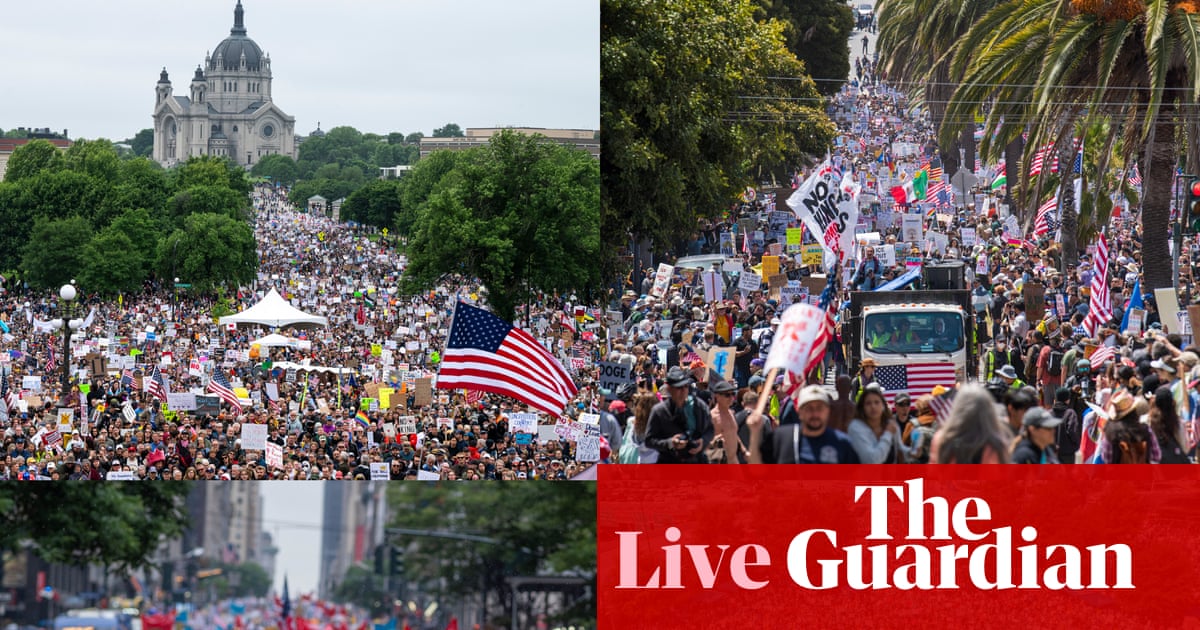
Key events
Michael Sainato
Recovery from a recent surgery for colon cancer will not stop James Phipps, 75, from attending Saturday’s No Kings demonstration in Chicago, Illinois. “I have a burning desire to be a part of the protest.” he said, “because that’s all I’ve done all my life.”
Phipps, born in Marks, Mississippi, was involved in the civil rights movement in the 1960s from the age of 13, when he was part of racially integrating his local high school and organising with the Student Nonviolent Coordinating Committee. At 15, he became involved in the Mississippi Freedom Labor Union (MFLU), which organised sharecroppers for better wages.
At the time, the MFLU was organising cotton pickers. “They were paid 30 cents an hour, working in the hot sun, 10 hours a day, which was $3, two and half cents per pound of cotton,” said Phipps. “It broke their necks, backs, pelvis and knees.”
“They had no medical care,” he added. “That’s one of the key things in my mind right now.”
Read more about how some of the largest labour unions in the US are involved in organising the No Kings protests, with more than 2,600 demonstrations planned across all 50 states:
Organisers say there are more than 2,500 protests planned across the country. Take a look at where they are expected to take place:
The protests start at different times depending on location. The No Kings website has details for each location.
What to know about the anti-Trump No Kings protests
Rachel Leingang
Millions are expected to show out for protests on Saturday at more than 2,500 locations across America, from small towns to large cities, to speak against the Trump administration.
No Kings, the coalition behind a mass demonstration in June, is again calling people to the streets to send the simple message that Donald Trump is not a king, pushing back against what they see as increasing authoritarianism.
Several US cities now have a militarised presence on the ground, most against the will of local leaders. Trump has promised to crack down on dissent as part of an ongoing retribution campaign. Still, organisers say they expect to see one of the largest, if not the largest, single day of protest in US history.
What are the No Kings protests?
A coalition of left-leaning groups is again leading a day of mass demonstrations across the US to protest against the Trump administration. The coalition spearheaded a previous No Kings protest day in June, drawing millions to the streets to speak out against the president on the same day Trump held a military parade in Washington.
The protests are called No Kings to underscore that America does not have kinds of absolute rulers, a ding against Trump’s increasing authoritarianism.
“‘NO KINGS’ is more than just a slogan; it is the foundation our nation was built upon,” a website for the protests, nokings.org, says. “Born in the streets, shouted by millions, carried on posters and chants, it echoes from city blocks to rural town squares, uniting people across this country to fight dictatorship together.”
Where are they happening?
Organisers say there are more than 2,500 protests planned across the country, in the largest cities and in small towns, and in all 50 states. It is part of a distributed model where people protest in their own communities rather than travelling to large urban hubs to show that discontent with Trump exists in all corners of the US.
For the 18 October day of action, organisers have identified several anchor cities: Washington DC; San Francisco; San Diego; Atlanta; New York City; Houston, Texas; Honolulu; Boston; Kansas City, Missouri; Bozeman, Montana; Chicago and New Orleans.
The protests start at different times depending on location. The No Kings website has a map with details for each location.
Read more about who organised the protests, why organisers are asking protesters to wear yellow, what Trump has said about them and more in our Q&A here:

Rachel Leingang
Donald Trump has promised to crack down on dissent and sent troops into US cities. His allies are claiming antifa, the decentralized antifascist movement, is behind plans to protest. He’s looking for any pretext to go after his opponents.
Still, this Saturday, even in cities with troops on the ground, millions of people are expected to march against the president as part of a second “No Kings” protest. The last No Kings protest in June drew several million people across more than 2,000 locations. This time, more than 2,500 cities and towns nationwide are hosting protests.
Read more about the preparation’s for Saturday’s protests here:
Opening summary
Hello and welcome to the Guardian’s coverage of the protests due to take place across the country on Saturday, dubbed ‘No Kings’ in protest at the Trump administration.
Leaders of the movement estimated during a press conference on Thursday that there will be more than 2,500 demonstrations throughout the US. “We do not expect there to be any need for the National Guard to be deployed, but if the Trump administration attempts to do that as a way to intimidate peaceful protests, we are prepared for that,” they added.
Leaders of the coalition also said that they don’t anticipate anything other than a peaceful protest, and don’t currently have any information that would suggest any outside agitator groups are planning to disrupt the coordinated demonstrations.
Millions of people turned out for similar protests on Saturday 14 June as Donald Trump held a military parade in the streets of Washington DC.
The protests took place at about 2,100 sites nationwide, from big cities to small towns. A coalition of more than 100 groups joined together to plan the protests, which are committed to a principle of nonviolence.
No Kings organizers estimated the day’s events drew millions of people, in all 50 states and to some cities abroad. These included more than 200,000 in New York and over 100,000 in Philadelphia, plus some small towns with sizable crowds for their populations, including the town of Pentwater, Michigan, which saw 400 people join the protest in their 800-person town, the No Kings coalition said.
The protests were largely peaceful, though some – in Los Angeles and Portland – were later deemed unlawful assembly by law enforcement and met with teargas.
The tenor of the day was also marked by political violence. There were two early morning shootings of two Democratic lawmakers in Minnesota, one of whom was killed along with her husband, in what local officials called a politically motivated attack. The state’s police and governor cautioned people to not attend demonstrations across the state “out of an abundance of caution”.
Earlier this week, Robert De Niro urged Americans to “stand up and be counted” in the protests, characterising Trump as an aspiring tyrant who aims to end American democracy.
Source link

